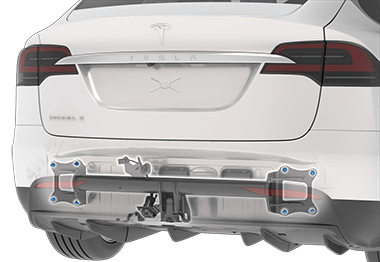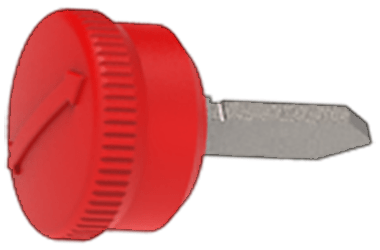Connecting and Disconnecting the Tow Hitch
Review the Owner's Manual for weight limits, best practices, and more information.
The Model X towing package includes a weight-carrying hitch with a 2 inch hitch receiver (for North America and Korea) or 50 mm ball coupling. When not in use, the hitch (and receiver, if equipped) should be removed and stored in a dry location to prevent rust and corrosion. Keep the dust cover over the hitch housing to prevent dirt and debris from entering.
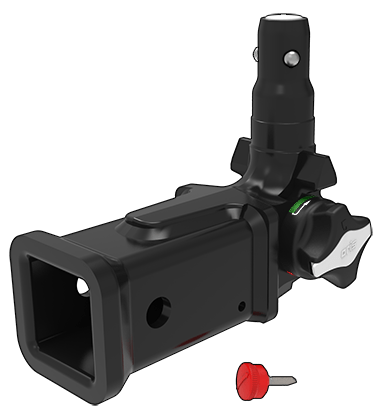
To install the trailer hitch receiver:
- Remove the dust cover from the hitch
housing.
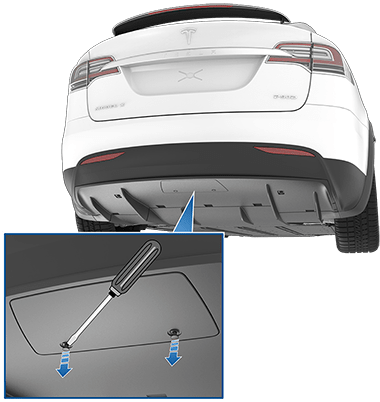 NoteModel X may have two push clips that secure the dust cover to the vehicle. To open, use a sharp object, such as a flat screwdriver, to carefully pry the clips open. Remove the dust cover.
NoteModel X may have two push clips that secure the dust cover to the vehicle. To open, use a sharp object, such as a flat screwdriver, to carefully pry the clips open. Remove the dust cover.
- Insert the key into the locking cylinder on the hitch, and turn the cylinder so the top of the key is aligned with the “unlocked” position.
- Pull the locking cylinder out of the
adapter approximately 1/8" (0.5 cm), and turn clockwise until the red marking on the
cylinder aligns with the white dot.
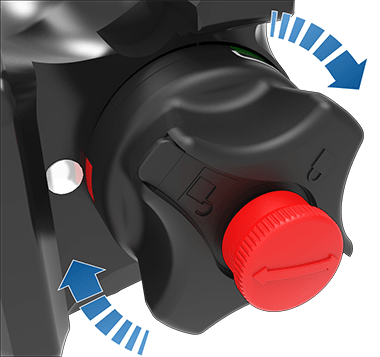 WarningBe careful when turning the locking cylinder. If it does not lock into the “Open Position”, it automatically retracts into its original “Closed Position” and can pinch your fingers.
WarningBe careful when turning the locking cylinder. If it does not lock into the “Open Position”, it automatically retracts into its original “Closed Position” and can pinch your fingers. - Firmly grasp the hitch from the
bottom and align the triangular-shaped guides at the sides of the hitch with the
corresponding cutouts in the hitch housing. NoteDo not grasp the locking cylinder because it needs to rotate freely.
- Push the hitch into the hitch housing until the locking cylinder rotates approximately 120° counter-clockwise and automatically locks into the "Closed Position". The green area on the locking cylinder (above the white arrow) aligns with the white dot on the housing.
- Visually check to confirm that the
hitch is fully inserted into the housing. Try pulling down on the hitch. The hitch
should not drop when you pull down.NoteIf the hitch does not lock into the housing, it falls out when you pull down on it.
- Turn the key so the arrows align with the “locked” marking on the locking cylinder.
- Remove the key and store it in a safe
place (preferably inside the vehicle).NoteThe key can be removed only if the hitch is locked. This indicates a proper connection. Do not use the hitch if the key is not removed.
- Close the dust cover to prevent dirt and debris from entering the lock. For newer version with push clips, reattach the dust cover, snap it in place and open the push clips before pushing them in.
Disconnecting the Tow Hitch
After towing, remove the hitch:
- Insert the key and turn to align the top of the key with the “unlocked” position.
- While firmly holding the bottom
of the hitch (to prevent it from dropping to the ground), pull the locking
cylinder out approximately 1/8" (0.5 cm), and turn it clockwise until the red
marking on the locking cylinder aligns with the white dot. At this point, the
locking cylinder is locked in the "open" and the hitch drops out of the
housing.WarningBe careful when turning the locking cylinder. If it does not lock into the “Open Position”, it automatically retracts into its original “closed" position and can pinch your fingers.
- Reinstall the dust cover on the hitch housing to prevent dirt from accumulating inside the housing.
- Close the dust cover on the hitch's locking cylinder and store the hitch in a secure location.
Attaching and Removing the Ball Mount (North America and Korea)
The Model X towing package does not include a ball mount. You must purchase a ball mount suitable for the type of trailer you are towing. The Model X hitch receiver supports a ball mount up to 8” with a rise of up to 0.75”. Do not use any type of drop ball mount.
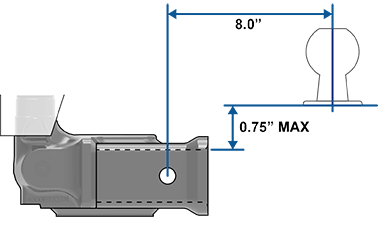
To attach a ball mount:
- If necessary, remove the cotter pin from the locking bolt and slide the locking bolt out of the hitch assembly.
- Slide the ball holder into the hitch assembly.
- Align the hole in the ball holder with the one in the hitch assembly.
- Slide the locking bolt through the hitch assembly/ball holder.
- Insert the cotter pin in the hole at the end of the locking bolt.
To remove a ball mount:
- Remove the cotter pin from the locking bolt and slide the locking bolt out of the ball holder/hitch assembly.
- Pull the ball holder out of the hitch assembly.
